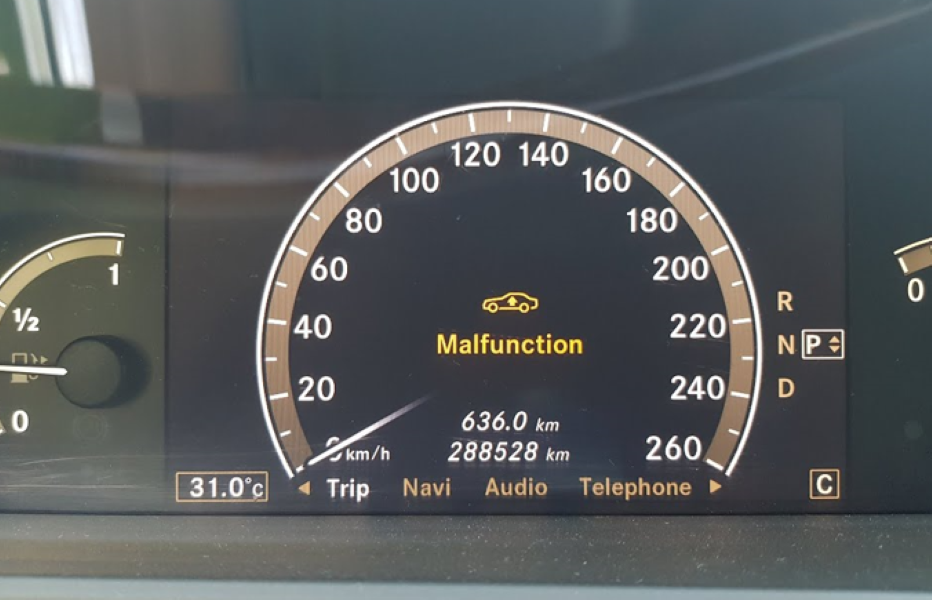Table of Contents
W221 S-Class AIRMATIC Calibration: Step-by-Step Ride Height Reset Guide
The Mercedes-Benz W221 S-Class is renowned for its luxury ride and advanced technology, much of which comes from the AIRMATIC suspension system. This system uses air springs, adaptive dampers, and smart sensors to continuously adjust ride height and damping, giving drivers a blend of comfort and precision.
However, after repairs to struts, compressors, or sensors, the system often requires recalibration. Without it, the S-Class may develop uneven stance, increased tire wear, or reduced handling stability.

Why Calibration Matters
Calibrating the W221 AIRMATIC suspension ensures that the system functions as Mercedes engineers intended.
Key Benefits of Calibration
- – Even ride height → Prevents uneven tire wear and lopsided stance.
- – Component adaptation → Compensates after replacing struts, compressors, or sensors.
- – Adaptive damping restored → Ensures precise sensor alignment for comfort and control.
- – Fault correction → Clears stored errors and restores factory settings.
What is AIRMATIC?
Unlike traditional steel springs, AIRMATIC uses air bellows (rubber and polyurethane) filled with pressurized air.
Advantages of AIRMATIC
- 1. Adaptive damping : Adjusts firmness based on road conditions.
- 2. Automatic level control : Keeps the car level regardless of passenger load or cargo.
- 3. Adjustable ride height : Allows raising for rough terrain or lowering for aerodynamics.
This system ensures the W221 S-Class remains stable, smooth, and safe in all conditions.

Common Symptoms of Lost Calibration
| Symptom | Description |
|---|---|
| Front higher than rear | Typical imbalance → 3–4 cm higher front stance |
| Chassis feels bouncy | Unequal ride height affects handling response |
| Compressor runs frequently | System constantly adjusting → calibration drift |
If you notice these, recalibration is likely required.
Why W221 AIRMATIC Calibration is Necessary
- 1. Performance: Over time, sensors drift from original settings → calibration restores precision.
- 2. Safety: Ensures proper road contact for braking and stability.
- 3. Comfort: Keeps ride smooth and adaptive.
- 4. Error resolution: Recalibration clears stored AIRMATIC faults.

W221 AIRMATIC Calibration Process
Tools You’ll Need
- – Mercedes STAR Diagnostic (Xentry) or OBD-II tool with suspension calibration.
- – Tape measure/digital caliper to check ride height.
- – Flat, level surface for accurate calibration.
Step 1: Diagnostic Scan
- – Connect Xentry Diagnostics to the OBD-II port.
- – Scan the suspension system for stored fault codes.
- – Address any air leaks, faulty sensors, or compressor faults before recalibration.
Step 2: System Reset
- – Clear existing suspension data in the AIRMATIC control module.
- – This restores factory defaults.
Step 3: Ride Height Adjustment
- – Measure distance from wheel hub center to fender arch at all four corners.
- – Enter baseline values into Xentry:
- Front: ~0 ± 2 mm; inclination ~+1.9° (per MB spec)
- Rear: ~0 ± 2 mm; inclination ~–1.9° to –2.0°
- – Adjust the air springs via diagnostic tool until ride height matches specifications.

Step 4: Sensor Calibration
- – Recalibrate height sensors to align with corrected ride height.
- – This ensures the ECU receives accurate data for auto-leveling.
Step 5: Test Drive Verification
- – Take vehicle on a short drive while monitoring live suspension data.
- – Confirm ride height remains consistent under load and road changes.
- – Measure post-drive ride height again (~380 mm ±3 mm wheel center to arch).
Step 6: Final Adjustments
- – Fine-tune any corners that remain slightly off.
- – Re-check for stored error codes and clear if necessary.
Common Issues & Solutions
| Problem | Likely Fix |
|---|---|
| Compressor cycles frequently | Check for leaks, test reservoir and valve block |
| Uneven ride height | Inspect/replace faulty sensors, recalibrate |
| Height drops overnight | Replace leaking struts or lines |
| Calibration fails | Ensure level surface and ±2 mm tolerance adjustments |
How to Reset AIRMATIC Suspension (W221)
If your W221 shows a suspension warning, you may need to reset the system.
Steps to Reset
- 1. Park safely: On flat surface, engage parking brake.
- 2. Connect diagnostic tool: Locate OBD-II port, connect Xentry or equivalent.
- 3. Power ignition: Switch to ON (do not start engine).
- 4. Access AIRMATIC module: Navigate to “Suspension” > “AIRMATIC.”
- 5. Read fault codes: Record and resolve underlying issues first.
- 6. Clear fault codes: Reset the ECU.
- 7. Perform recalibration: Select “Reset/Recalibrate Suspension.”
- 8. Cycle ignition: OFF for 1 min, then ON again.
- 9. Test system: Start engine, check ride height response.
- 10. Test drive: Verify smooth ride and correct stance.
Tip: Minor resets may sometimes work by holding the in-car suspension button until height cycles, but full recalibration is more reliable.
Mercedes AIRMATIC Reset vs. Full Calibration
- – Reset: Clears codes, reinitializes suspension. Best for minor faults.
- – Calibration: Adjusts height values and sensors. Needed after repairs or uneven ride height.
Explore More Mercedes Suspension Issues
For a deeper dive into suspension problems such as uneven ride height, AIRMATIC malfunctions, “Stop Vehicle Too Low” warnings, and vibration faults, visit our hub: Mercedes-Benz Suspension Issues – Symptoms, Causes & Fixes. There you’ll find grouped case studies, step-by-step diagnostics, symptom, cause, fix tables, and preventive tips to keep your Mercedes riding smoothly.
FAQs
Q: How often should W221 AIRMATIC calibration be done?
A: Only after component replacement (struts, compressor, sensors) or when uneven ride height is observed.
Q: Can I calibrate AIRMATIC without Xentry?
A: Some OBD-II tools support it, but Xentry is strongly recommended for accuracy.
Q: How much does calibration cost?
A: Independent workshops charge around $200–$400, while dealerships may charge more.
Q: Can leaks cause calibration failure?
A: Yes. Calibration won’t hold if leaks exist in air springs, lines, or valve blocks.
Q: What happens if I skip calibration after repairs?
A: The car may lean to one side, cause uneven tire wear, and compromise safety.
Conclusion
The W221 AIRMATIC calibration process is crucial for keeping the S-Class driving as it should smooth, safe, and balanced. Whether after strut replacement, compressor repair, or sensor servicing, recalibration ensures the suspension system operates to factory standards.
By following a systematic process diagnostic scanning, resetting, height adjustments, and sensor calibration technicians can restore the W221’s suspension to its original precision.
For Mercedes owners, the takeaway is clear: if your car feels uneven, bouncy, or displays a suspension warning, a W221 AIRMATIC calibration or reset is essential. Done correctly, it will restore the legendary ride comfort that defines the S-Class.
Author
Written by Mercedes Expert
With years of hands-on experience diagnosing and repairing Mercedes-Benz systems, he brings technical depth and practical case studies to help car owners, technicians, and enthusiasts troubleshoot complex automotive issues. His work focuses on clear repair guides, OEM-level procedures, and knowledge-sharing to empower both professionals and drivers.
Last Updated: September 2025
— Salim, Mercedes Expert
Independent specialist in Mercedes-Benz diagnostics, CAN Bus analysis, troubleshooting case studies, and EV systems.







Leave a Reply